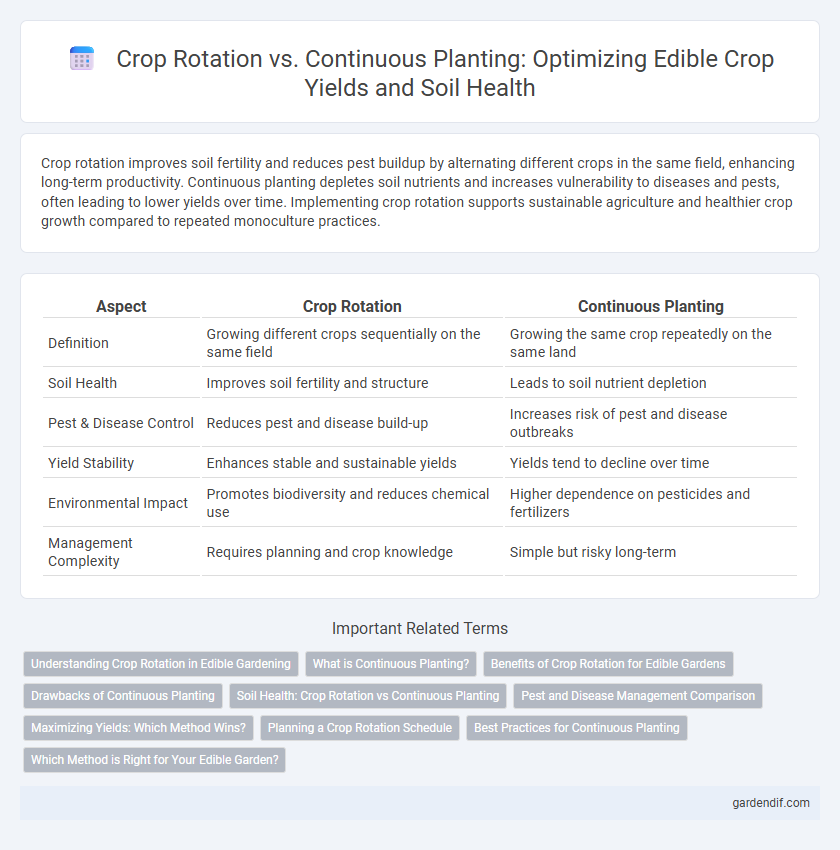
Crop Rotation vs Continuous Planting Illustration
Crop rotation improves soil fertility and reduces pest buildup by alternating different crops in the same field, enhancing long-term productivity. Continuous planting depletes soil nutrients and increases vulnerability to diseases and pests, often leading to lower yields over time. Implementing crop rotation supports sustainable agriculture and healthier crop growth compared to repeated monoculture practices.
Table of Comparison
| Aspect | Crop Rotation | Continuous Planting |
|---|---|---|
| Definition | Growing different crops sequentially on the same field | Growing the same crop repeatedly on the same land |
| Soil Health | Improves soil fertility and structure | Leads to soil nutrient depletion |
| Pest & Disease Control | Reduces pest and disease build-up | Increases risk of pest and disease outbreaks |
| Yield Stability | Enhances stable and sustainable yields | Yields tend to decline over time |
| Environmental Impact | Promotes biodiversity and reduces chemical use | Higher dependence on pesticides and fertilizers |
| Management Complexity | Requires planning and crop knowledge | Simple but risky long-term |
Understanding Crop Rotation in Edible Gardening
Crop rotation in edible gardening improves soil fertility and reduces pest and disease buildup by alternating different plant families each growing season. This practice enhances nutrient cycling, preventing nutrient depletion common in continuous planting that exhausts soil quality. Implementing crop rotation promotes sustainable garden productivity and healthier edible crops through balanced ecosystem management.
What is Continuous Planting?
Continuous planting involves growing the same crop on the same land season after season without rotating with different crops, which can lead to soil nutrient depletion and increased pest and disease pressure. This practice often results in reduced soil fertility and higher susceptibility to crop-specific pathogens. Crop rotation, by contrast, helps maintain soil health and break pest cycles by alternating crops with different nutrient needs and pest resistances.
Benefits of Crop Rotation for Edible Gardens
Crop rotation enhances soil fertility by replenishing essential nutrients and reducing the buildup of pests and diseases common in edible gardens. It promotes healthier plant growth and higher yields by alternating crops with different nutrient demands and root structures. This sustainable practice improves soil structure and biodiversity, leading to more resilient and productive edible garden ecosystems.
Drawbacks of Continuous Planting
Continuous planting depletes soil nutrients rapidly, increasing the need for synthetic fertilizers that can harm the environment. It also promotes the buildup of pests and diseases specific to the crop, reducing overall yield and crop health. Soil structure deteriorates over time, leading to erosion and decreased water retention, which undermine sustainable edible crop production.
Soil Health: Crop Rotation vs Continuous Planting
Crop rotation enhances soil health by diversifying nutrient demands and reducing soil-borne diseases, whereas continuous planting depletes specific nutrients and increases pest buildup. Rotating crops improves soil structure and microbial diversity, promoting natural fertility and resilience. Continuous monoculture often leads to soil degradation, lowering long-term productivity and increasing dependency on chemical inputs.
Pest and Disease Management Comparison
Crop rotation disrupts pest and disease life cycles by alternating crops, which reduces the buildup of specific pathogens and insect populations in the soil. Continuous planting of the same crop encourages the proliferation of host-specific pests and diseases, leading to increased infestation and infection rates. Implementing crop rotation enhances soil health and pest resistance, minimizing the reliance on chemical pesticides and promoting sustainable edible crop production.
Maximizing Yields: Which Method Wins?
Crop rotation significantly enhances soil fertility and disrupts pest life cycles, leading to increased crop yields compared to continuous planting. Continuous planting often depletes essential nutrients, resulting in reduced soil health and lower productivity over time. Research consistently shows that crop rotation can improve yield by up to 20-30% through better nutrient management and pest control.
Planning a Crop Rotation Schedule
Planning a crop rotation schedule involves selecting diverse crops with varying nutrient requirements to maintain soil fertility and reduce pest infestations. Incorporating legumes improves nitrogen levels, while alternating deep-rooted and shallow-rooted plants enhances soil structure. Effective scheduling maximizes yield, minimizes disease buildup, and promotes sustainable farming practices.
Best Practices for Continuous Planting
Continuous planting demands careful management of soil nutrients and pest control to maintain crop health and yield. Implementing crop diversification within continuous planting schedules helps reduce pathogen buildup and soil depletion. Regular soil testing, targeted fertilization, and integrated pest management are essential best practices to optimize productivity in continuous planting systems.
Which Method is Right for Your Edible Garden?
Crop rotation enhances soil fertility and reduces pest buildup by alternating plant families each season, which supports healthier and more productive edible gardens. Continuous planting may maximize short-term yields but often depletes soil nutrients and increases the risk of disease and pest infestations. Evaluating soil health, garden size, and crop types helps determine if rotating crops or maintaining a continuous planting strategy best suits your edible garden's long-term sustainability and productivity.
Crop Rotation vs Continuous Planting Infographic

 gardendif.com
gardendif.com